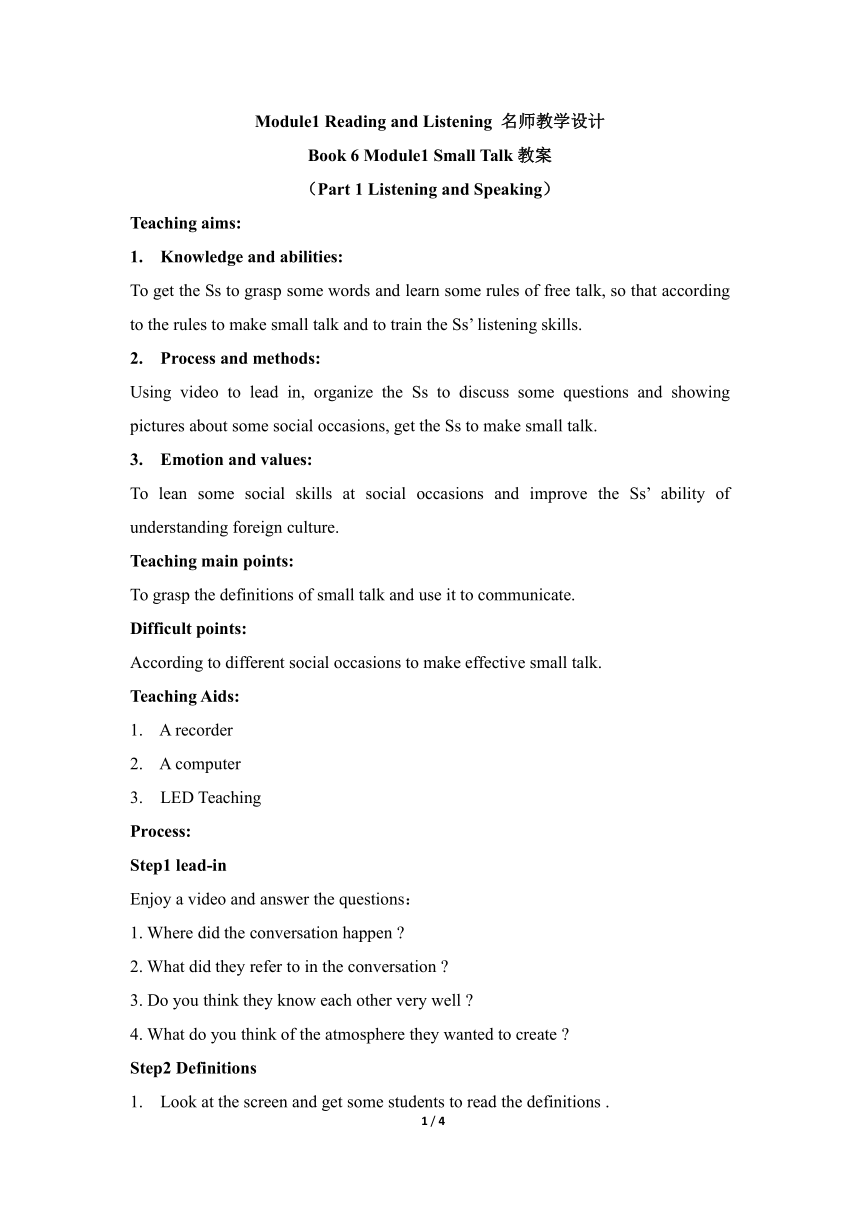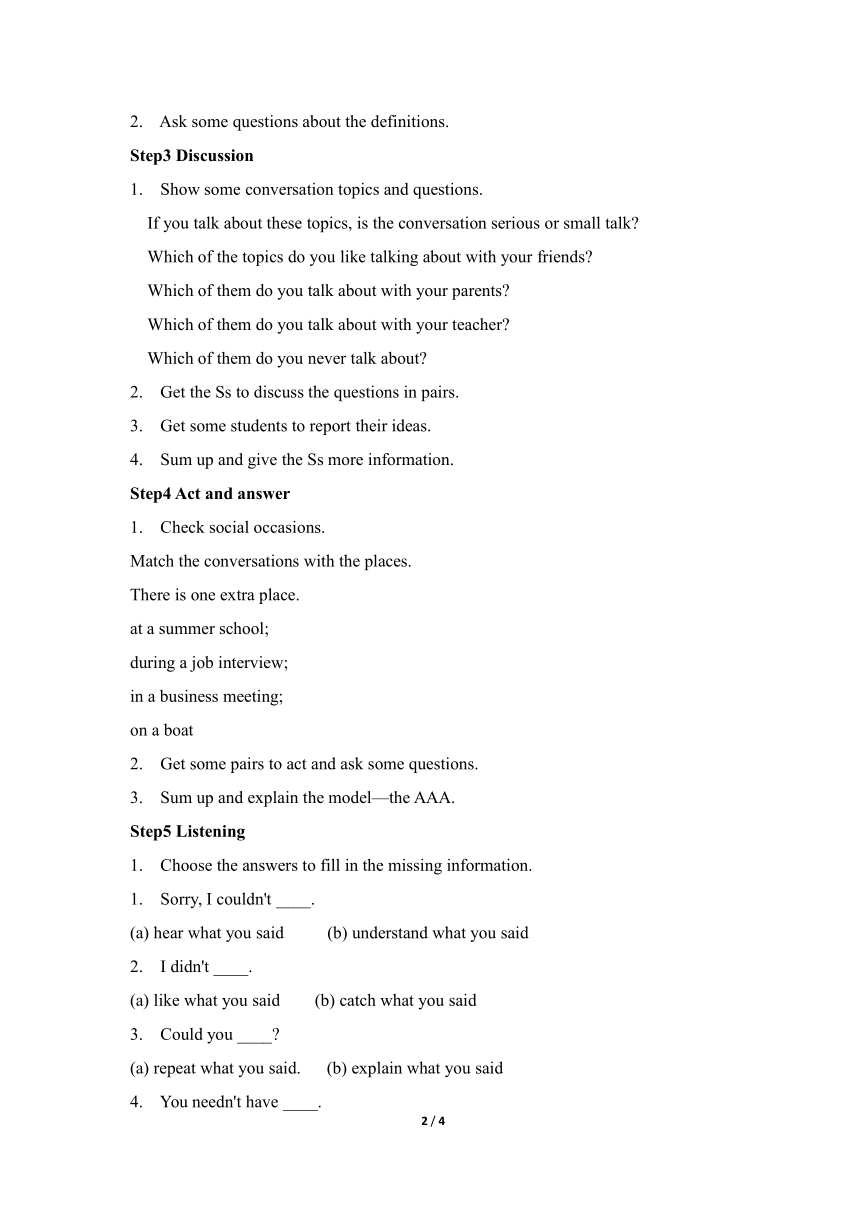外研版选修6 Module1 Small Talk Reading and Listening名师教学设计
文档属性
| 名称 | 外研版选修6 Module1 Small Talk Reading and Listening名师教学设计 |  | |
| 格式 | doc | ||
| 文件大小 | 45.5KB | ||
| 资源类型 | 教案 | ||
| 版本资源 | 外研版 | ||
| 科目 | 英语 | ||
| 更新时间 | 2023-02-17 12:40:11 | ||
图片预览


文档简介
Module1 Reading and Listening 名师教学设计
Book 6 Module1 Small Talk教案
(Part 1 Listening and Speaking)
Teaching aims:
1. Knowledge and abilities:
To get the Ss to grasp some words and learn some rules of free talk, so that according to the rules to make small talk and to train the Ss’ listening skills.
2. Process and methods:
Using video to lead in, organize the Ss to discuss some questions and showing pictures about some social occasions, get the Ss to make small talk.
3. Emotion and values:
To lean some social skills at social occasions and improve the Ss’ ability of understanding foreign culture.
Teaching main points:
To grasp the definitions of small talk and use it to communicate.
Difficult points:
According to different social occasions to make effective small talk.
Teaching Aids:
1. A recorder
2. A computer
3. LED Teaching
Process:
Step1 lead-in
Enjoy a video and answer the questions:
1. Where did the conversation happen
2. What did they refer to in the conversation
3. Do you think they know each other very well
4. What do you think of the atmosphere they wanted to create
Step2 Definitions
1. Look at the screen and get some students to read the definitions .
2. Ask some questions about the definitions.
Step3 Discussion
1. Show some conversation topics and questions.
If you talk about these topics, is the conversation serious or small talk
Which of the topics do you like talking about with your friends
Which of them do you talk about with your parents
Which of them do you talk about with your teacher
Which of them do you never talk about
2. Get the Ss to discuss the questions in pairs.
3. Get some students to report their ideas.
4. Sum up and give the Ss more information.
Step4 Act and answer
1. Check social occasions.
Match the conversations with the places.
There is one extra place.
at a summer school;
during a job interview;
in a business meeting;
on a boat
2. Get some pairs to act and ask some questions.
3. Sum up and explain the model—the AAA.
Step5 Listening
1. Choose the answers to fill in the missing information.
1. Sorry, I couldn't ____.
(a) hear what you said (b) understand what you said
2. I didn't ____.
(a) like what you said (b) catch what you said
3. Could you ____
(a) repeat what you said. (b) explain what you said
4. You needn't have ____.
(a) spoken to me (b) spoken so slowly
5. I just needed a few seconds ____.
(a) to get used to your voice (b) to understand your voice
2. Listen and answer the questions.
Do the people both speak English as a first language
Why did the woman have problems understanding what the man was saying
How did the man help her to understand him better
4. Explain: …needn’t have done…
Read the sentence from the listening passage and answer the questions.
You needn't have spoken so slowly.
1. Who said this ———— the tourist or the English person
2. Why did she say it ( )
(a) The other person was speaking quickly.
(b) The other person was speaking too slowly.
(c) The other person was speaking too slowly and it wasn't necessary.
Step6 Small Talk
1. Using some pictures to show some social occasions.
2. Get the Ss to make small talk in pairs.
3. Get some pairs to act out their small talk.
Step7 Homework
Think and discuss some questions.
Is small talk important in your society
Is it as important as "real" conversation
Do you think small talk is more or less important in English than in your language
Writing on the Bb:
Module1 Small Talk 1. the AAA—— answer, add, ask 2. You needn’t have spoken so slowly. …needn’t have done…: It wasn’t necessary. .
1 / 4
Book 6 Module1 Small Talk教案
(Part 1 Listening and Speaking)
Teaching aims:
1. Knowledge and abilities:
To get the Ss to grasp some words and learn some rules of free talk, so that according to the rules to make small talk and to train the Ss’ listening skills.
2. Process and methods:
Using video to lead in, organize the Ss to discuss some questions and showing pictures about some social occasions, get the Ss to make small talk.
3. Emotion and values:
To lean some social skills at social occasions and improve the Ss’ ability of understanding foreign culture.
Teaching main points:
To grasp the definitions of small talk and use it to communicate.
Difficult points:
According to different social occasions to make effective small talk.
Teaching Aids:
1. A recorder
2. A computer
3. LED Teaching
Process:
Step1 lead-in
Enjoy a video and answer the questions:
1. Where did the conversation happen
2. What did they refer to in the conversation
3. Do you think they know each other very well
4. What do you think of the atmosphere they wanted to create
Step2 Definitions
1. Look at the screen and get some students to read the definitions .
2. Ask some questions about the definitions.
Step3 Discussion
1. Show some conversation topics and questions.
If you talk about these topics, is the conversation serious or small talk
Which of the topics do you like talking about with your friends
Which of them do you talk about with your parents
Which of them do you talk about with your teacher
Which of them do you never talk about
2. Get the Ss to discuss the questions in pairs.
3. Get some students to report their ideas.
4. Sum up and give the Ss more information.
Step4 Act and answer
1. Check social occasions.
Match the conversations with the places.
There is one extra place.
at a summer school;
during a job interview;
in a business meeting;
on a boat
2. Get some pairs to act and ask some questions.
3. Sum up and explain the model—the AAA.
Step5 Listening
1. Choose the answers to fill in the missing information.
1. Sorry, I couldn't ____.
(a) hear what you said (b) understand what you said
2. I didn't ____.
(a) like what you said (b) catch what you said
3. Could you ____
(a) repeat what you said. (b) explain what you said
4. You needn't have ____.
(a) spoken to me (b) spoken so slowly
5. I just needed a few seconds ____.
(a) to get used to your voice (b) to understand your voice
2. Listen and answer the questions.
Do the people both speak English as a first language
Why did the woman have problems understanding what the man was saying
How did the man help her to understand him better
4. Explain: …needn’t have done…
Read the sentence from the listening passage and answer the questions.
You needn't have spoken so slowly.
1. Who said this ———— the tourist or the English person
2. Why did she say it ( )
(a) The other person was speaking quickly.
(b) The other person was speaking too slowly.
(c) The other person was speaking too slowly and it wasn't necessary.
Step6 Small Talk
1. Using some pictures to show some social occasions.
2. Get the Ss to make small talk in pairs.
3. Get some pairs to act out their small talk.
Step7 Homework
Think and discuss some questions.
Is small talk important in your society
Is it as important as "real" conversation
Do you think small talk is more or less important in English than in your language
Writing on the Bb:
Module1 Small Talk 1. the AAA—— answer, add, ask 2. You needn’t have spoken so slowly. …needn’t have done…: It wasn’t necessary. .
1 / 4
